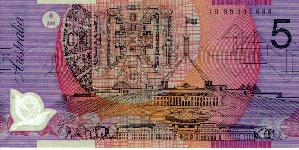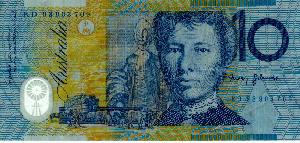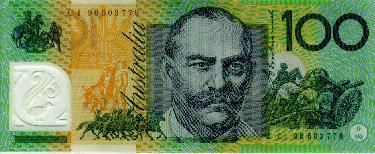Welcome to....
Hello, and welcome to my page devoted to the interesting world
of Australian banknotes. For the time being, only images and
information regarding the current series of plastic polymer notes
will be displayed until I can gain further information and images
of older series of Aussie banknotes.

The $5 note


FRONT:
The front of the $5 note features a prtrait of H.M. Queen
Elizabeth II, the current head of state of Australia. It also
features a gum tree branch.
BACK:
The back of the $5 note is dominated by architectural plans for
the Australian Parliament House, opened in 1988 to coincide with
the bicentenary of European settlement. The old Parliament House
(completed in 1927) is also displayed.
CLEARPIECE:
The clear plastic window (known to some as the clearpiece)
features a stylised gum flower (which complements the gum tree
branch on the left of the front of the note).
The $10 note


FRONT:
The front of the "tenner" or the "blue tounge" features
Australia's best loved poet, A.B. "Banjo" Paterson (1864-1941),
who wrote Australia's favourite national song, "Waltzing Matilda"
and other poems and ballads such as "The Man From Snowy River"
and "The Man From Ironbark". The horse chase on the note is taken
from a scene in "The Man From Snowy River".
BACK:
This side of the note features Dame Mary Gilmore (1865-1962),
noted for her patriotic poems and articles, whose most famous work
is the anthology "The Wild Swan". The back of this note also
features an agricultural scene, reminding Australians of this
important part of the country's economic history.
CLEARPIECE:
The clearpiece continues with the rural theme of the $10 note,
which features a simplified drawing of an artesian bore windmill
(used to pump underground water to the surface), a common sight
throughout outback Australia.
The $20 note


FRONT:
This note (often known as a "red-back") features Mary Reibey
(1777-1855), an English convict transported to Australia as
punsihment (for fraud I believe, but
I may be wrong on that point) who turned good and built extensive
business interests in the fledgling colony of New South Wales.
It also features a ship and Georgian era commercial houses,
representing this woman's achievements in colonial Australia.
BACK:
John Flynn (1880-1951), the founder of the Royal Flying Doctor's
Service (an essential service to those living in the 'bush'),
features on the back of this note. Also on the back of the $20
note are medical diagrams, a plane used by the RDFS, a pedal-operated
radio, and an explorer crossing the desert on a camel.
CLEARPIECE:
The clearpiece on the $20 is a simplified compass... perhaps to
commemorate the explorers and pioneers who opened up the inland?
Or as a statement that, as a nation, we know where we are headed..
The $50 note


FRONT:
The front of the fifty features David Unaipon, a nineteenth-century
Aboriginal writer and inventor. Also included on the $50 are
some of Unaipon's scientific drawings, his writings and a small
chapel (I think this is an Aboriginal mission, but I'm not
entirely sure).
BACK:
Edith Cowan (1861-1932), a prominent social worker and campaigner
of the early twentieth-century is honoured on the back of the
$50 note. Cowan was also the first female parliamentarian anywhere
in Australia (in the Western Australian state parliament,
which I believe is the building featured). She
is shown on the note speaking to parliament, and a family from
the Depression era (or thereabouts) is also depicted.
CLEARPIECE:
The clearpiece on this note features the Southern Cross, the
pricipal element on the Australian flag and representative of
our location (as the Southern Cross can only be seen from the
southern hemisphere). The four main stars each have seven points
and each star is known as "The Federation Star", with six points
to represent each state and one more to represent Australia's
territories.
The $100 note


FRONT:
Dame Nellie Melba (1861-1931), arguably the greatest opera singer
of all time, adorns the front of the largest note of the series,
the $100 note. Also featured is Dame Nellie Melba singing on a
stage and some opera paraphernalia.
BACK:
John Monash (1865-1931) is featured on the back of this banknote.
Monash is often seen as the man who won World War One for the
allies with his innovations in warfare at the time. Also featured
is the badge of the Commonwealth Military Forces (the branch of
the military which Monash served), a representation of Simpson
and his donkey (yet another legend from the War), and a World
War One artillery unit.
CLEARPIECE:
The clearpiece cosists of a modern representation of a lyrebird,
a native bird similar to a peacock which can be found in the
forests of south-eastern Australia. The asme bird also features
on the Australian ten-cent piece.
My warmest thanks go to Ben Cooke (aka "Zoltan") for providing
me with the scans on this page. He has my eternal gratitude.
I also credit the Macquarie Dictionary with providing me with
some of the biographical information of most of the people
honoured by our plastic polymer series of banknotes.


This page hosted by  Get your own Free Home Page
Get your own Free Home Page














![]() Get your own Free Home Page
Get your own Free Home Page